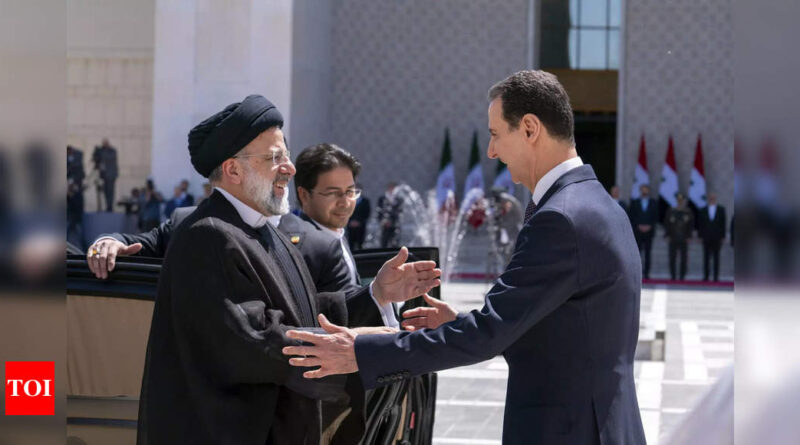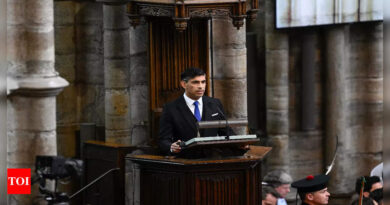Iran’s president Raisi holds rare meeting with Assad in Syria – Times of India
DAMASCUS: Iranian President Ebrahim Raisi Wednesday met Syrian President Bashar Assad in Damascus in a bid to boost cooperation between the two allies, state media reported.
Tehran has been a main backer of Assad’s government since an uprising turned into a full-blown war in March 2011 and has played an instrumental role in turning the tide in his favor.
Iran has sent scores of military advisers and thousands of Iran-backed fighters from around the Middle East to fight on Assad’s side. With the help of Russia and Iran, Syrian government forces have controlled large parts of the country in recent years.
In an interview with pan-Arab television channel Al-Mayadeen, Raisi called for reconstruction efforts and for refugees who fled the country’s war to return to the country.
Raisi, who is a leading a high-ranking political and economic delegation in a two-day visit to Syria, was received on arrival at Damascus International Airport Wednesday by Syrian Economy Minister Samer al-Khalil.
“Syria’s government and people have gone through great hardship,” Syrian state media quoted Raisi telling Assad during the meeting. “Today, we can now say that you have overcome all these problems and were victorious despite the threats and sanctions imposed against you.”
He is also set to visit the Sayida Zeinab and Sayida Ruqayya shrines, both holy sites in Shiite Islam, as well as the Tomb of the Unknown Soldier, a monument dedicated to Syrian soldiers killed in battle.
The last Iranian president to visit Syria was President Mahmoud Ahmadinejad in 2010.
The Iranian president’s visit comes as some Arab countries, including regional powerhouses Egypt and Saudi Arabia, have been opening up to Assad and their foreign ministers have visited Damascus in recent weeks. Syria’s foreign minister also visited the Saudi capital of Riyadh in April, the first such visit since the two countries cut relations in 2012.
In March, Iran and Saudi Arabia, a main backer of Syrian opposition fighters, reached an agreement in China to re-establish diplomatic relations and reopen embassies after seven years of tensions.
The reconciliation between Iran and Saudi Arabia is likely to have positive effects on regional states where the two countries fought proxy wars, including Syria.
Syria was widely shunned by Arab governments over Assad’s brutal crackdown on protesters and the breakdown in relations culminated with Syria being ousted from the Arab League in 2011. The conflict has since killed nearly half a million people and displaced half of Syria’s pre-war population of 23 million.
“America and its allies failed on all fronts against the resistance, and could not achieve any of their goals,” Iran’s new ambassador to Syria Hossein Akbari told Iran’s state news agency on Tuesday.
Like Syria, Iran is under western sanctions, which alongside decades of mismanagement, has plunged its national currency to new lows. Months of anti-government protests failed to unseat ruling clerics and return to the 2015 nuclear deal with world powers, which lifted sanctions in exchange for restrictions on Iran’s nuclear program.
In 2015, Iran’s currency was trading at 32,000 rials to the dollar when it signed a nuclear accord with world powers. In February it hit a record low of 600,000.
The Iranian president’s visit also comes a week after its Minister for Road and Urban Development Mehrdad Bazrpash met Assad in Damascus, where he delivered a message from the Iranian president supporting the expansion of economic relations between the two countries, according to Iran’s state news agency.
Iran’s military presence in Syria been a major concern for Israel, which has vowed to stop Iranian entrenchment along its northern border. Israel has carried out hundreds of strikes on targets in government-controlled parts of Syria in recent years — but rarely acknowledges them. Since the beginning of 2023, Syrian officials have attributed a dozen strikes on Syrian territory to Israel, the latest of which came early Tuesday and put the international airport of the northern city of Aleppo out of service.
Tehran has been a main backer of Assad’s government since an uprising turned into a full-blown war in March 2011 and has played an instrumental role in turning the tide in his favor.
Iran has sent scores of military advisers and thousands of Iran-backed fighters from around the Middle East to fight on Assad’s side. With the help of Russia and Iran, Syrian government forces have controlled large parts of the country in recent years.
In an interview with pan-Arab television channel Al-Mayadeen, Raisi called for reconstruction efforts and for refugees who fled the country’s war to return to the country.
Raisi, who is a leading a high-ranking political and economic delegation in a two-day visit to Syria, was received on arrival at Damascus International Airport Wednesday by Syrian Economy Minister Samer al-Khalil.
“Syria’s government and people have gone through great hardship,” Syrian state media quoted Raisi telling Assad during the meeting. “Today, we can now say that you have overcome all these problems and were victorious despite the threats and sanctions imposed against you.”
He is also set to visit the Sayida Zeinab and Sayida Ruqayya shrines, both holy sites in Shiite Islam, as well as the Tomb of the Unknown Soldier, a monument dedicated to Syrian soldiers killed in battle.
The last Iranian president to visit Syria was President Mahmoud Ahmadinejad in 2010.
The Iranian president’s visit comes as some Arab countries, including regional powerhouses Egypt and Saudi Arabia, have been opening up to Assad and their foreign ministers have visited Damascus in recent weeks. Syria’s foreign minister also visited the Saudi capital of Riyadh in April, the first such visit since the two countries cut relations in 2012.
In March, Iran and Saudi Arabia, a main backer of Syrian opposition fighters, reached an agreement in China to re-establish diplomatic relations and reopen embassies after seven years of tensions.
The reconciliation between Iran and Saudi Arabia is likely to have positive effects on regional states where the two countries fought proxy wars, including Syria.
Syria was widely shunned by Arab governments over Assad’s brutal crackdown on protesters and the breakdown in relations culminated with Syria being ousted from the Arab League in 2011. The conflict has since killed nearly half a million people and displaced half of Syria’s pre-war population of 23 million.
“America and its allies failed on all fronts against the resistance, and could not achieve any of their goals,” Iran’s new ambassador to Syria Hossein Akbari told Iran’s state news agency on Tuesday.
Like Syria, Iran is under western sanctions, which alongside decades of mismanagement, has plunged its national currency to new lows. Months of anti-government protests failed to unseat ruling clerics and return to the 2015 nuclear deal with world powers, which lifted sanctions in exchange for restrictions on Iran’s nuclear program.
In 2015, Iran’s currency was trading at 32,000 rials to the dollar when it signed a nuclear accord with world powers. In February it hit a record low of 600,000.
The Iranian president’s visit also comes a week after its Minister for Road and Urban Development Mehrdad Bazrpash met Assad in Damascus, where he delivered a message from the Iranian president supporting the expansion of economic relations between the two countries, according to Iran’s state news agency.
Iran’s military presence in Syria been a major concern for Israel, which has vowed to stop Iranian entrenchment along its northern border. Israel has carried out hundreds of strikes on targets in government-controlled parts of Syria in recent years — but rarely acknowledges them. Since the beginning of 2023, Syrian officials have attributed a dozen strikes on Syrian territory to Israel, the latest of which came early Tuesday and put the international airport of the northern city of Aleppo out of service.




